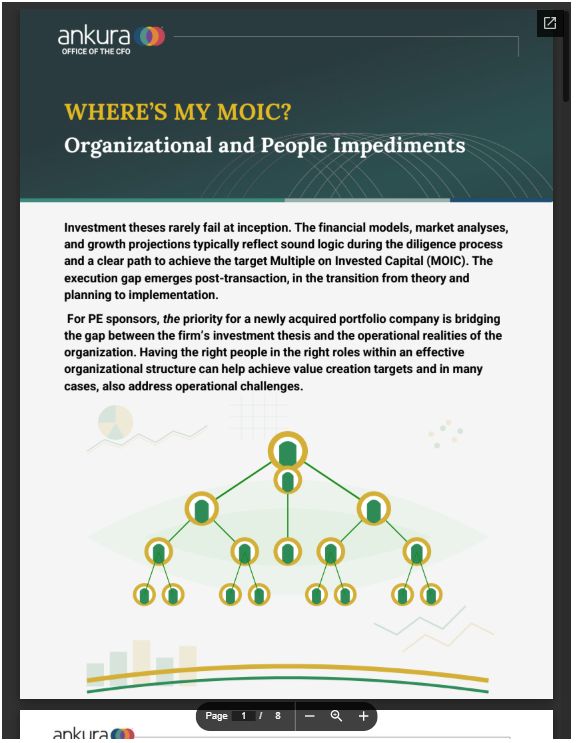- within Corporate/Commercial Law topic(s)
- within Insurance, Wealth Management and Tax topic(s)
Investment theses rarely fail at inception. The financial models, market analyses, and growth projections typically reflect sound logic during the diligence process and a clear path to achieve the target Multiple on Invested Capital (MOIC). The execution gap emerges post-transaction, in the transition from theory and planning to implementation.
For private equity (PE) sponsors, the priority for a newly acquired portfolio company is bridging the gap between the firm's investment thesis and the operational realities of the organization. Having the right people in the right roles within an effective organizational structure can help achieve value creation targets and, in many cases, also address operational challenges.
Disentangling People, Process, and Technology
When portfolio companies underperform, distinguishing between people-driven issues and systemic problems is critical yet challenging. Talented individuals may appear ineffective because they are hampered by broken processes, inadequate technology, or a lack of direction.
Key questions sponsors should ask themselves include:
- Are performance shortfalls consistent across teams or concentrated in specific functions?
- Do high performers hired from outside struggle after joining the organization?
- Are employees exhibiting resistance to change or lacking the tools to implement it?
- Are employees prioritizing and focusing on the highest value activities?
- Are incentive programs aligned with value creation targets?
| What We Hear from Sponsors | Possible People or Organizational Culprits |
|---|---|
| Financial reporting is limited and lacks insights |
|
| Revenues are below forecast |
|
| Leadership cannot explain the root cause of poor performance |
|
| Strategic initiatives are taking too long, and status is unclear |
|
| Leadership is not aligned on strategic priorities |
|
| Costs for back-office functions are above industry standards |
|
| The organization is struggling with adoption and change |
|
Assessing the Finance Organization
An assessment of the finance function's operating model is the first step to achieving an efficient and effective finance organization. The assessment should include a thorough evaluation of the organization's current capabilities, including identifying skill gaps, assessing leadership effectiveness, and understanding barriers to performance.
Targeted external support offers a unique perspective and objectivity and can be instrumental in developing an objective assessment of the finance organization.
- Cross-Functional Perspective: External advisors operate across structures that historically reinforce functional boundaries
- Data-Driven Objectivity: Evaluates performance through an objective lens, leveraging data analysis and factual insights focused on value creation
- External Perspective: Leverage experience to provide a new point of view and help avoid blind spots that arise from decision-making based solely on institutional knowledge
The People-to-MOIC Bridge
The most effective assessments combine quantitative metrics with qualitative insights from across the organization, creating a comprehensive view of organizational health. Further, the assessment should zero-in on the finance organization's ability to serve as a strategic partner to the broader organization as well as an enabler of growth. In other words, can the finance organization – including its people – support the broader organization in achieving the desired MOIC?
Just as CFOs develop Cash-to-EBITDA bridges to track financial performance, assessments of the finance function should incorporate frameworks for measuring how people initiatives directly impact MOIC. This "People-to-MOIC Bridge" quantifies the financial impact of organizational improvements through metrics such as cost of finance per employee, potential productivity gains from organizational restructuring, and expected cost reductions from improved spans and layers.
Implementation of Solutions
The purpose of the assessment is to identify critical challenges and solutions to strengthen the finance organization and bolster its ability to serve the objectives of the sponsor. External advisors can also be supportive of implementation efforts to ensure accountability and speed.
Ensure that transformation programs are set up for success with some key steps:
- Establish success metrics: Tie program key performance indices (KPIs) directly to MOIC impact and overarching sponsor goals
- Design discrete, time-bound initiatives rather than an open ended program: Clearly outline and align on milestones and key deadlines
- Develop program governance: Develop a structure with roles and responsibilities, clear decision rights, escalation pathways, and accountability mechanisms to govern the transformation
- Focus on enablement: Position external support as enhancing or upskilling the team's capabilities rather than replacing them
- Emphasize quick wins: Intentionally sequence initiatives to deliver visible results within the first 60-90 days to build credibility and demonstrate value, creating positive momentum for deeper structural
Finance Organization Imperatives Across the Investment Lifecycle
The finance organization can be assessed and improved at any stage, though organizational priorities may shift depending on how long the sponsors have held the company as an investment.
| Hold Period | Focus Areas |
|---|---|
| Early Hold Period (Years 1-2) |
|
| Mid-Hold Period (Years 3-4) |
|
| Late Hold Period (Years 5+) |
|
By tailoring strategies to these investment stages, sponsors can maximize the impact of people initiatives on MOIC throughout the holding period.
How Ankura Office of the CFO® Supports Clients
Ankura Office of the CFO® brings together seasoned financial and operational leaders who have sat in the CFO's chair and understand the complex challenges of delivering on behalf of PE sponsors. We help portfolio companies bridge the gap between investment thesis and operational reality through targeted interventions that drive measurable results. Our approach emphasizes knowledge transfer, capability building, and ensures sustainable performance improvement long after our engagement concludes.
|
Org Structure & Talent |
Org Design (incl. SSC, BPO) | Design future state org structure with defined spans & layers, implement service delivery strategy, and develop monitoring capabilities. |
| Interim Management | Serve in Finance leadership roles and support transformation, transition, hiring, and training. | |
| Job Descriptions, Roles & Responsibilities, Training | Draft job descriptions, build responsibility assignment matrices, create training materials and facilitate knowledge transfer. |
|
eporting & Governance |
Benchmarking, Cost to Serve | Identify and analyze key benchmarks and implement performance improvement plans. |
| Delegation of Authority (DoA), Decision Rights | Analyze, align, and implement DoA and governance models. | |
| Headcount Analytics, Dashboarding | Develop analytics and dashboards that are integrated with financial actuals and forecast. |
|
Delivery Excellence |
Process Ownership | Define process ownership, align underlying activities to requirements, establish process taxonomies, and identify cross-functional interdependencies. |
| Tools & Automation | Develop tools and automate manual processes to drive efficiencies across Finance. Enable greater focus on higher value-add activity with technology. | |
| Transaction Management | Manage complex business integrations (or spinoffs) resulting from M&A or consolidations. Support org and talent strategy through transaction lifecycle. |
Our practice is distinguished by its implementation focus – we measure our success not by the quality of our recommendations, but by the tangible value we help create. We engage as true partners, aligning our incentives with your outcomes and adapting our approach to your unique organizational context. The MOIC clock is ticking. You want Execution CertaintyTM. Let us deliver together, with confidence.
Case Study 1: Enabling Finance & Accounting to Scale for Growth
A PE-owned single-family rental (SFR) company grew rapidly, tripling the size of its portfolio in about a year. Amidst a large transformation to enable scalability, compliance issues were identified and became public, posing a significant risk to customer and investor confidence. The company also struggled with an inefficient organizational structure that inhibited transparent communication between departments and up to leadership.
The company retained our team to assess and improve the organization's risk universe, remediate compliance issues, establish a proper governance structure to facilitate change, and design a future state operating model to enable the finance and accounting functions to scale for growth.
Our diagnostic revealed that while the company had been hiring aggressively, it had failed to establish a performance-driven culture with appropriate accountability mechanisms. Employees had the technical capabilities needed but lacked clarity about expectations and how their roles contributed to value creation. Furthermore, the siloed organizational structure prevented the cross-functional collaboration essential for addressing compliance issues.
We implemented a comprehensive transformation program that began with redesigning the organizational structure to eliminate silos and establish clear lines of accountability. Further, members of our team served in interim roles, including VP of Internal Audit and Chief Accounting Officer, bringing credibility and stability to support the functions as they scaled. Our team also advised on key process redesigns and established company-wide compliance programs to improve accountability and transparency.
As a result, the company experienced improved partnership across finance, accounting, and operations, increased rigor in data and reporting, and a stabilized risk universe. The company was able to engage in a public securitization process, allowing the PE sponsors to realize MOIC potential.
Case Study 2: Upskilling a Finance Org Pre-IPO
A global hospitality company sought a return to public markets following a leveraged private equity buy-out and a cross-country headquarters relocation. However, the company's finance and accounting functions lacked both clarity in roles and responsibilities and the appropriate skill sets to support public company operations. These shortcomings necessitated a reorganization of people and processes before the company would be IPO-ready.
Our assessment revealed that the underlying issue was not simply skill gaps, but rather a culture resistant to the discipline required for public company reporting. The organization had talented individuals who were misaligned with their roles and operating in an environment that did not support continuous improvement or accountability. Further, relocation disrupted institutional knowledge transfer, while the absence of documented processes created inconsistent performance across teams.
We implemented a cultural transformation program alongside the technical preparations for initial public offering (IPO), fostering an environment where rigorous financial controls and process discipline became core values. This included establishing a "curiosity council" where team members regularly evaluated processes for improvement opportunities and created communities of practice to accelerate knowledge sharing.
Further, the company looked to our team to take on Chief Accounting Officer and Chief of Staff roles on an interim basis while the finance and accounting functions prepared for IPO and instituted accounting policies and governance to support public company requirements. They further engaged our team to fill interim financial planning and analysis (FP&A) roles to develop a long-range plan and design a future state operating model for the finance function. While supporting IPO preparations, we integrated and onboarded over 40 new team members and implemented communication protocols to enhance collaboration, awareness, and team cohesion, leaving footprints in the sand to support the team's future success.
By designing an appropriate future state operating model and bringing structure to the accounting and finance functions, our team successfully prepared the company for an IPO in advance of private equity sponsor and management expectations.
The content of this article is intended to provide a general guide to the subject matter. Specialist advice should be sought about your specific circumstances.




